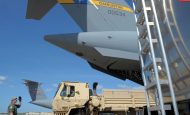
MARINE CORPS BASE HAWAII, Hawaii: A team of Airmen from the 315th Airlift Wing, Joint Base Charleston, South Carolina, trained in rapid response deployment scenarios during exercise Patriot Palm with joint-service members from the Marines, Coast Guard, Army and FBI Jan. 27-30 at Marine Corps Base Hawaii.
One of the key players in the exercise was the 315th Contingency Response Flight, which is part of the 315th AW. Starting from a bare base, CRF units are meant to set up an operating airfield within only hours.
For example, contingency response units responded to the 2010 earthquake in Haiti, Hurricane Maria in 2017 and set up bases in Iraq and Afghanistan. These units are how civil authorities such as Federal Emergency Management Agency, Department of Homeland Security, Department of Justice and others are able to fly equipment and people during disaster responses.
Since the exercise was focused on rapid response, the CRF provided many necessities such as field communications, amongst other things. With at least half of the flight’s annual equipment budget going to new communication technology, it is pertinent to work out any preventable hindrances in the case of an emergency.
Field communication can run into barriers, “the mountainous terrain of Hawaii is difficult to bounce communication signals across,” said Tech. Sgt. Nicholas Tyndal, 512th Contingency Response Squadron radio frequency transitions technician from Dover Air Force Base, Delaware, who joined the 315th CRF for the exercise. “After several years in the Air Force, I’m glad I’ve had the opportunity to train in a new environment that helps us pin-point issues with our new equipment. We’ve already solved so many issues in a short amount of time.”
One of the issues that the CRF had to overcome during the exercise was bridging the gap between participating teams, such as the 315th Aeromedical Evacuation Squadron from JB Charleston and the control center. Without the troubleshooting conducted by Tyndal and his communications team, the lines of communication would not have been able to relay information on mock patients during the exercise.
“The overall exercise is to train deploying contingency response units as well as aeromedical evacuation teams and to let the affiliates like the FBI rapid deployment teams, the Coast Guard and Army units, to train on deployment readiness as well,” said Lt. Col. Greg Schnurrenberger, 315th CRF director of operations.
Those existing affiliates with the CRF have documented partnerships that allow them to have cargo carried on Air Force aircraft. Master Sgt. Robert Deal, 315th CRF affiliation manager, said that participating units and organizations have an existing affiliation with a CRF.
The agreement highlights strict requirements and urgent restrictions, such as a reaction time for moving all cargo, equipment and personnel within as little as 72 hours or less.
U.S. Transportation Command and Air Force Reserve Command use these guidelines to answer the call of duty with air mobility support. Additionally, through exercises such as Patriot Palm, military members from various careers, everything from communications to air transportation, receive vital training that keeps them current and ever ready.
Air transportation Airmen from the 81st, 38th and 437th Aerial Port Squadrons, came out to inspect, prepare and load thousands of pounds of cargo to ensure that it was airworthy for all affiliates.
“We get a multitude of training,” Schnurrenberger said. “We have several members that are in training, so the exercise builds toward our readiness, and it’s also building partnerships with our affiliates as well as with active duty.”
Building partnerships is a foundation for exercises like Patriot Palm, in which the 315th CRF helped train various branches of the military, such as the Marines at MCB Hawaii.
“It’s valuable training for the embarkation Marines,” said Chief Warrant Officer 2 Matthew Ford, a mobility officer at MCB Hawaii. “They’re trained to be Air Mobility Command-certified. However, they rarely get the opportunity to actually train with Air Force assets, such as a C-17, since we now utilize more surface assets than air assets for major movements.”
Since each branch or affiliate airlifts a variety of equipment specific to their organizations through the AMC it is pertinent to have expertise in preparation.
“Deployment readiness exercises help us get ready for homeland operations and homeland defense,” said Army Reserve Maj. Robert Blome, 807th Medical Command deployment support chemical, biological, radiological, nuclear and explosives response enterprise program coordinator. “Our framework is built to be able to rapidly respond if forces are needed to help on the home front. The deployment readiness exercises help significantly with all the details and coordination that impact timing and being able to go in time–96 hours or less.”
During Patriot Palm, Airmen, Soldiers, Coast Guardsmen and other partners were able to receive hands-on experience with loading unique cargo onto aircraft, ranging from medical equipment to U.S. Coast Guard vessels.
“It’s always a new experience,” said Coast Guard Lt. Cmdr. Leo Danaher, Maritime Safety and Security Team Honolulu commanding officer. “We depend on airlift to move our equipment because we are the only MSST that is not within the continental United States. Without this training we would have to depend on outside sources, as opposed to the military.”
With all of these affiliates being located on the West Coast of the U.S. or already in Hawaii, the 315th AW was able to meet the needs of a wide audience during Patriot Palm in a cost effective manner.
The 315th CRF provided the 315th AES and other team members seamless training.
“Our bottom line is to improve our wartime mission,” said Capt. Jonathan White, 315th AES Medical Service Corps officer. “The goal is to challenge our people in environments they aren’t used to, work efficiently with other service members across the country seamlessly, and to reach our main objective ‘anytime, anywhere.’”
Click here for original story, Multiservice exercise Patriot Palm enhances joint operability
Source: Air Force News